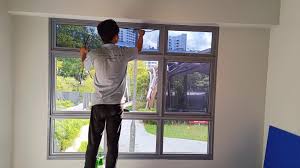
In recent years, window films have gained widespread recognition ultraviolet film for windows for their versatility, energy-saving potential, and aesthetic appeal. These thin layers of material, typically made of polyester or similar substances, are designed to be applied directly to the surface of windows, offering a range of benefits to both residential and commercial properties. From improving comfort and privacy to reducing energy consumption, window films are becoming an essential element in modern building designs.
What Are Window Films?
Window films are ultra-thin layers of material, usually adhesive-backed, that are applied to the glass surface of windows. These films come in a variety of types and can be used for multiple purposes, such as:
- UV Protection: Some films block harmful ultraviolet (UV) rays from the sun, which are known to cause fading in furniture, flooring, and other interior elements.
- Heat Rejection: Films can be engineered to reflect or absorb infrared radiation, helping to regulate indoor temperatures by preventing heat from penetrating through the glass.
- Privacy and Security: Certain window films are designed to obscure the view into a space while still allowing for natural light, offering enhanced privacy. Some films even improve security by making the glass harder to break.
- Glare Reduction: Window films can reduce the glare from the sun, providing a more comfortable living or working environment, especially in spaces with lots of direct sunlight.
- Decorative Effects: Decorative films can change the appearance of windows, offering a variety of styles, colors, and textures to suit the aesthetic needs of a space.
Types of Window Films
The diversity of window films available on the market means that there is likely a solution for virtually any need or preference. Some of the most common types of window films include:
- Tinted Films: These films add color to the windows, reducing glare and enhancing privacy while also offering some UV protection. Tinted films can be available in shades ranging from light to dark, and they are often used in residential or commercial buildings to improve the appearance and comfort of the space.
- Reflective Films: Reflective window films contain a metallic layer that reflects sunlight, reducing heat and glare. These films can be highly effective in hot climates or buildings that experience a lot of direct sunlight. They are often used in commercial buildings or high-rise offices to reduce cooling costs.
- Ceramic Films: Ceramic window films are more advanced and provide superior heat rejection and UV protection without the reflective appearance of traditional films. These films are made from ceramic particles that allow for high optical clarity while maintaining excellent performance.
- Frosted Films: Frosted films provide a frosted or etched glass appearance that enhances privacy without compromising natural light. These films are often used in bathrooms, office spaces, or conference rooms where visual privacy is essential.
- Security Films: These films are specifically designed to make windows more resistant to shattering, which can improve security and safety. Security films are often used in high-risk areas, such as ground-floor windows or in places prone to storms or break-ins.
- Anti-Graffiti Films: Designed to protect windows from vandalism, these films are ideal for businesses or public spaces where the risk of graffiti is high. They allow the surface to be easily cleaned or replaced without replacing the entire window.
Benefits of Window Films
1. Energy Efficiency and Cost Savings
One of the primary reasons people invest in window films is their energy-saving potential. By reducing the amount of heat entering or escaping through the windows, these films can significantly lower heating and cooling costs. In fact, some studies have shown that homes and buildings with window films can see energy savings of up to 30%. Additionally, films help maintain a more stable indoor temperature, making HVAC systems more efficient and reducing the overall environmental impact.
2. Enhanced Comfort
By minimizing heat gain or loss and reducing glare, window films create a more comfortable indoor environment. This is particularly beneficial in spaces with large windows or sun-facing rooms, where direct sunlight can cause uneven temperatures or harsh glare. With window films, the indoor environment becomes more balanced and pleasant.
3. UV Protection and Health Benefits
UV rays, though invisible to the naked eye, can cause skin damage and increase the risk of skin cancer. Window films that block UV radiation (up to 99%) help to protect people from harmful sun exposure while indoors. They also prevent furniture, flooring, and artwork from fading over time due to UV damage.
4. Increased Privacy
Certain types of window films can obscure the view from the outside without blocking natural light. This is ideal for homeowners who want to maintain their privacy without having to resort to heavy curtains or blinds. It’s also beneficial for businesses that wish to keep sensitive operations confidential while still allowing for an open and airy atmosphere.
5. Safety and Security
Security films provide added protection by making windows more resistant to shattering. In the event of a break-in, the film holds the broken glass together, preventing shards from scattering and causing injuries. Security films can also help protect buildings from natural disasters like storms, reducing the risk of flying glass and debris.
6. Aesthetic Appeal
Window films can completely transform the look of a building, whether it’s through a sleek, reflective finish or a frosted appearance that adds sophistication and elegance. For businesses, decorative films can be used to showcase logos, branding, or unique visual designs that complement the building’s overall aesthetic.
The Installation Process
The installation of window films is a straightforward process, though it’s typically best left to professionals for the best results. It involves cleaning the window surface, cutting the film to the appropriate size, and carefully applying it to the glass with an adhesive backing. The film is then smoothed out to remove any bubbles or wrinkles, ensuring a flawless finish.
For those looking to apply the film themselves, there are DIY kits available, though they require precise handling and attention to detail to achieve a professional look.
Conclusion
Window films are a practical, cost-effective, and visually appealing solution for improving comfort, security, and energy efficiency in any building. From reducing glare and heat to increasing privacy and protecting your interiors from UV damage, these films provide a range of benefits that make them a worthwhile investment. With a variety of styles and types available, there is a window film solution to suit every need and enhance the look and feel of your space. Whether you’re looking to improve the energy efficiency of your home or add a layer of protection and privacy to your office, window films are an innovative and effective option.
